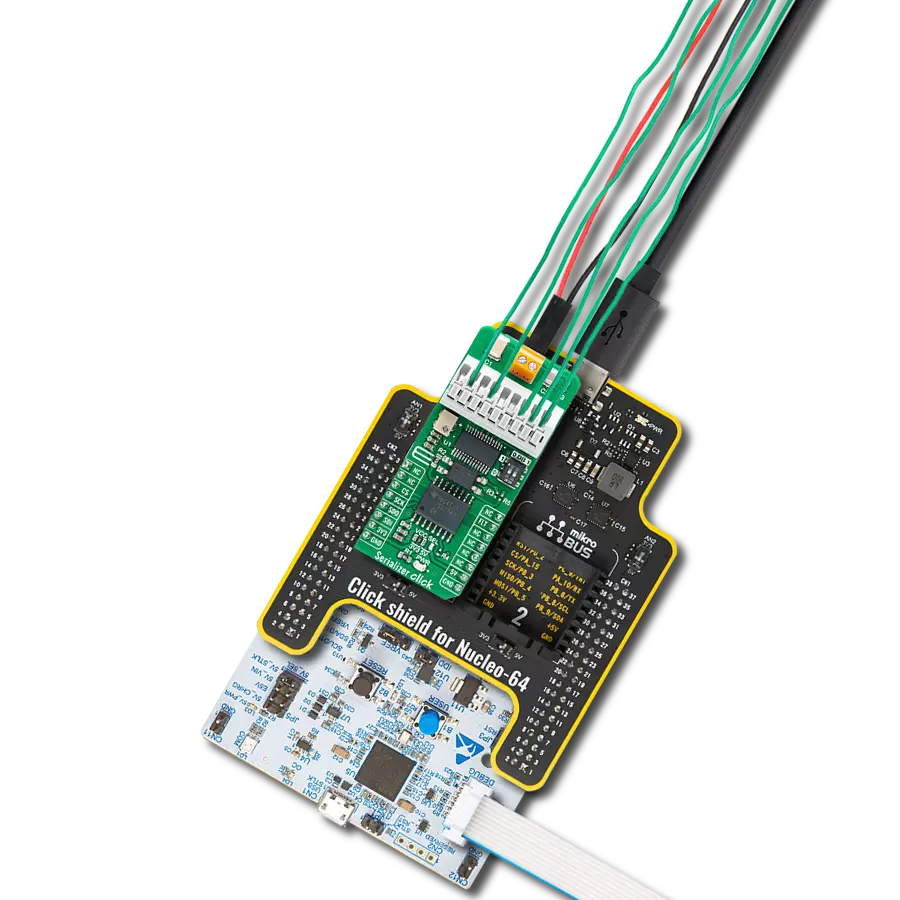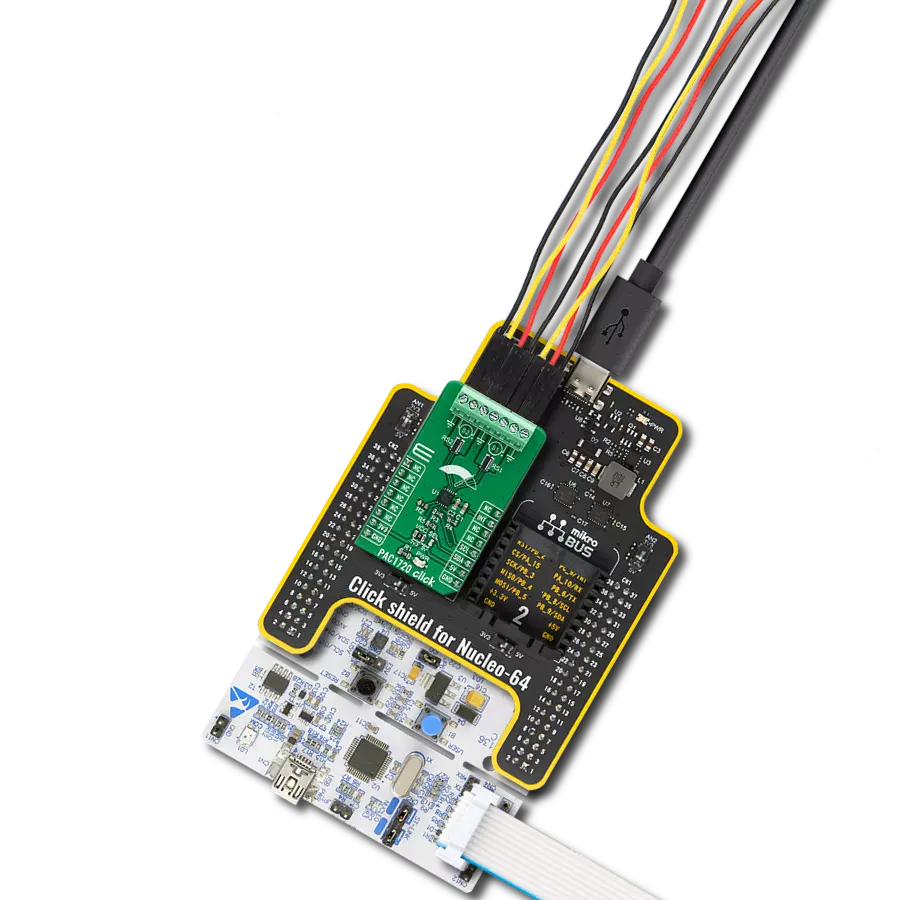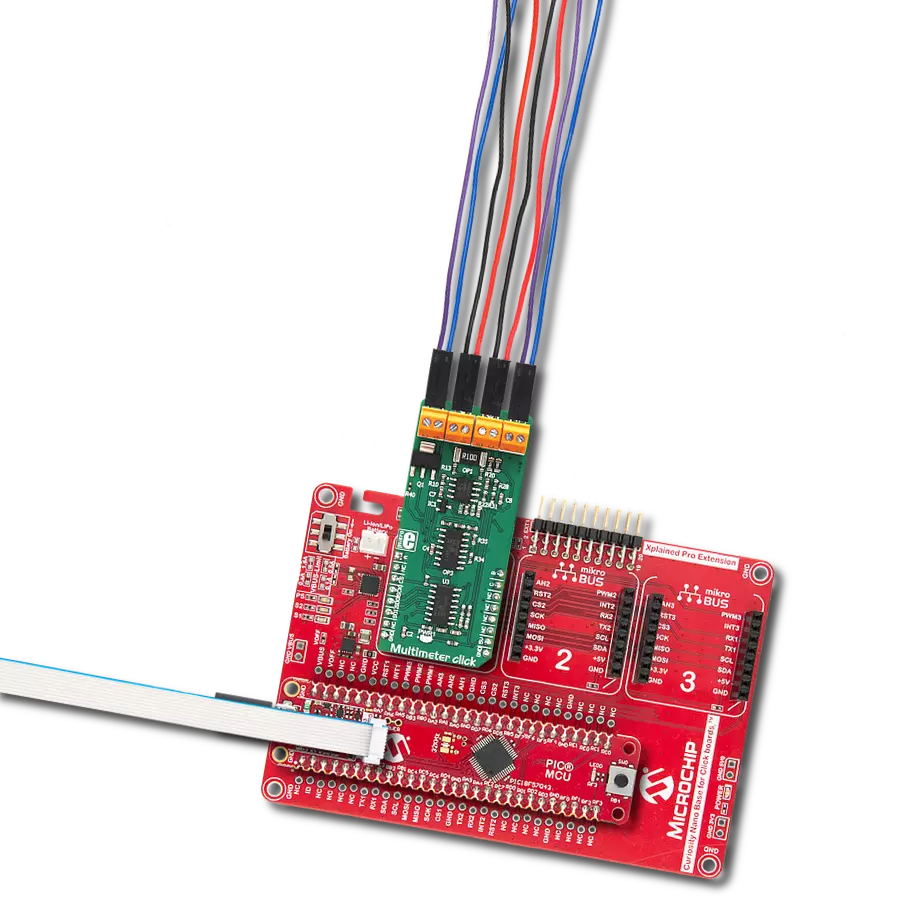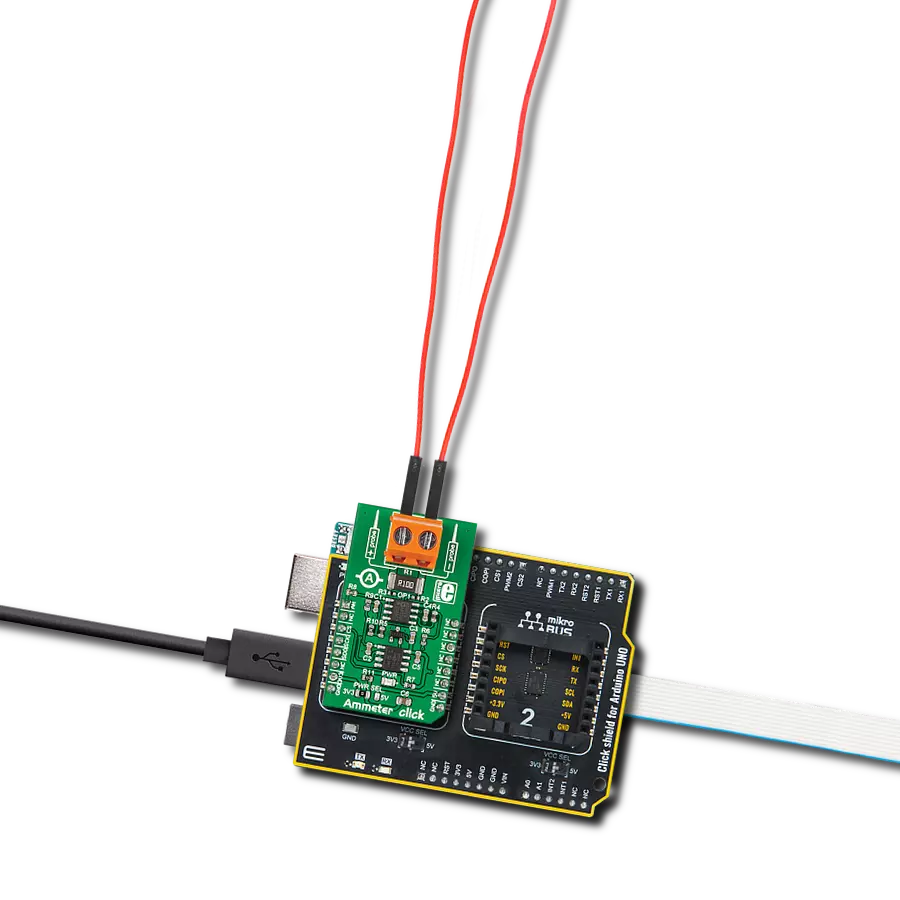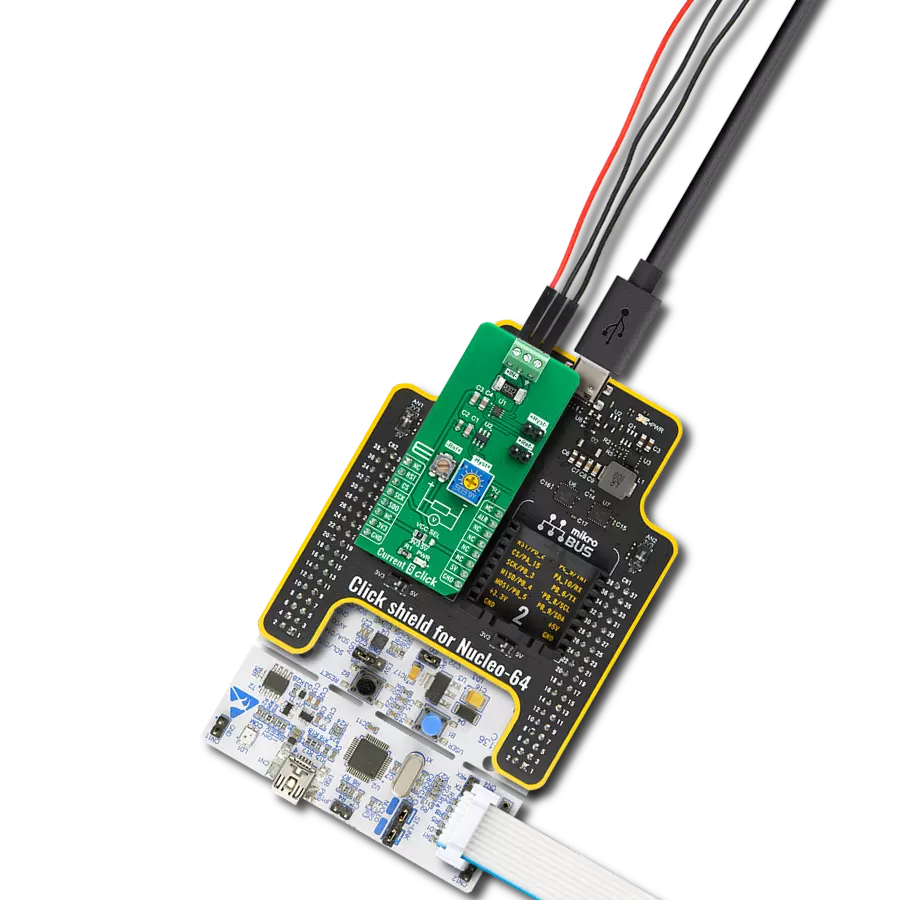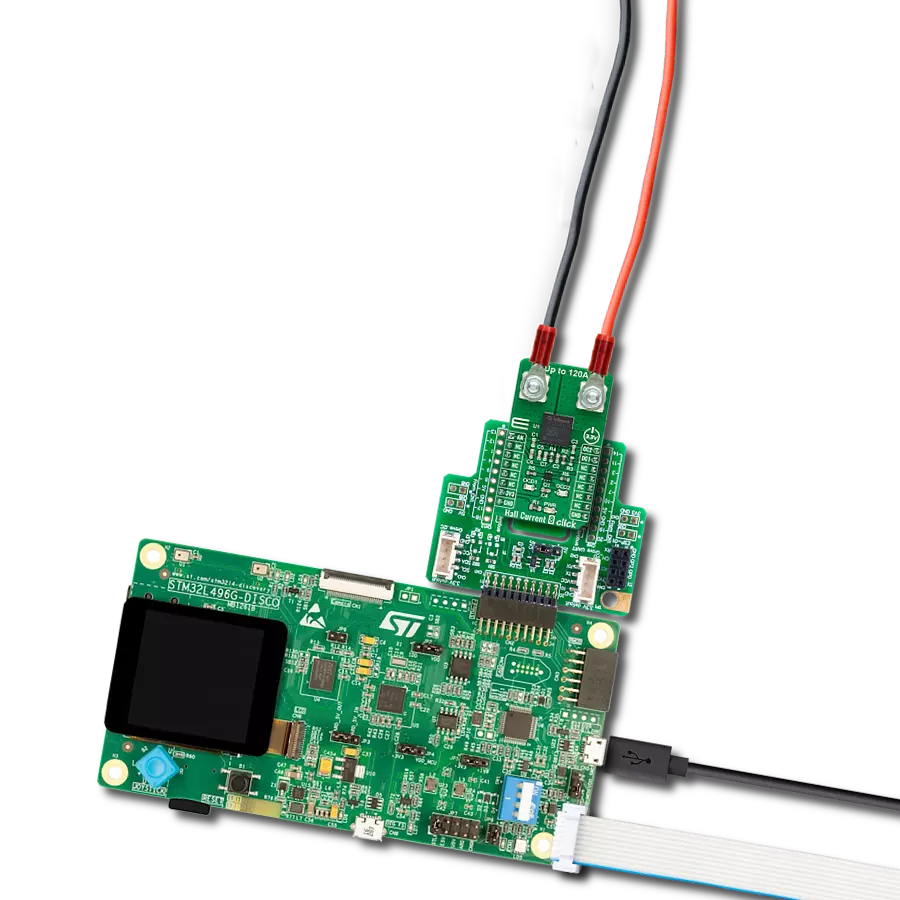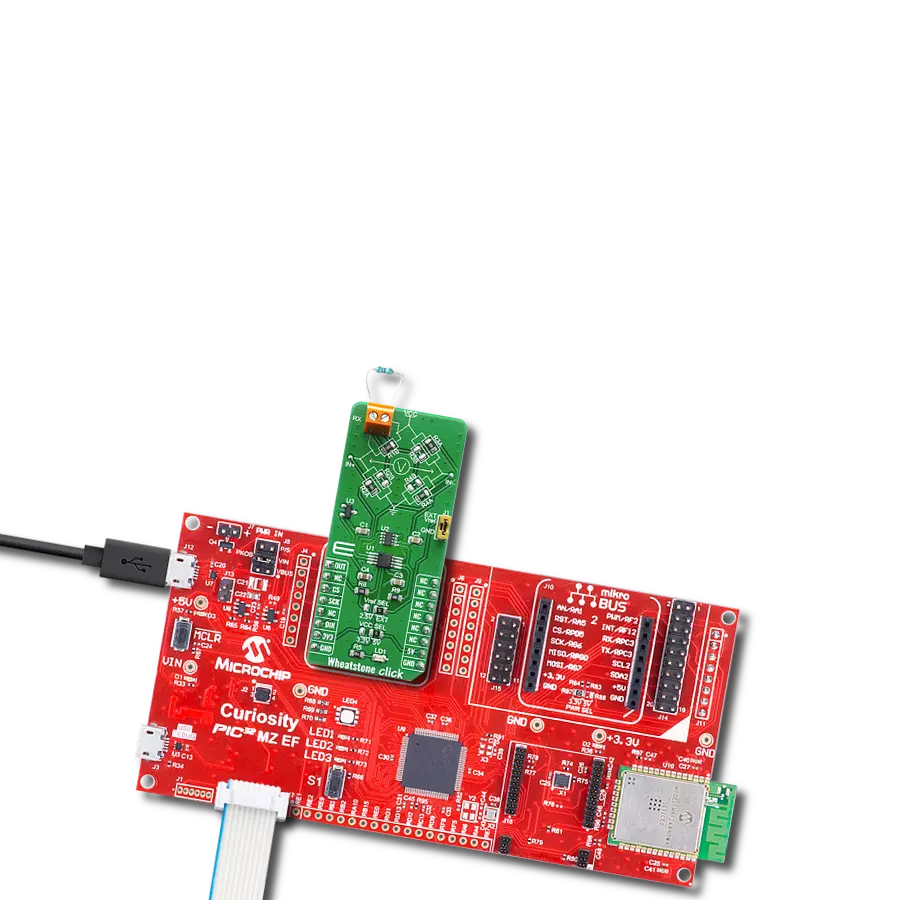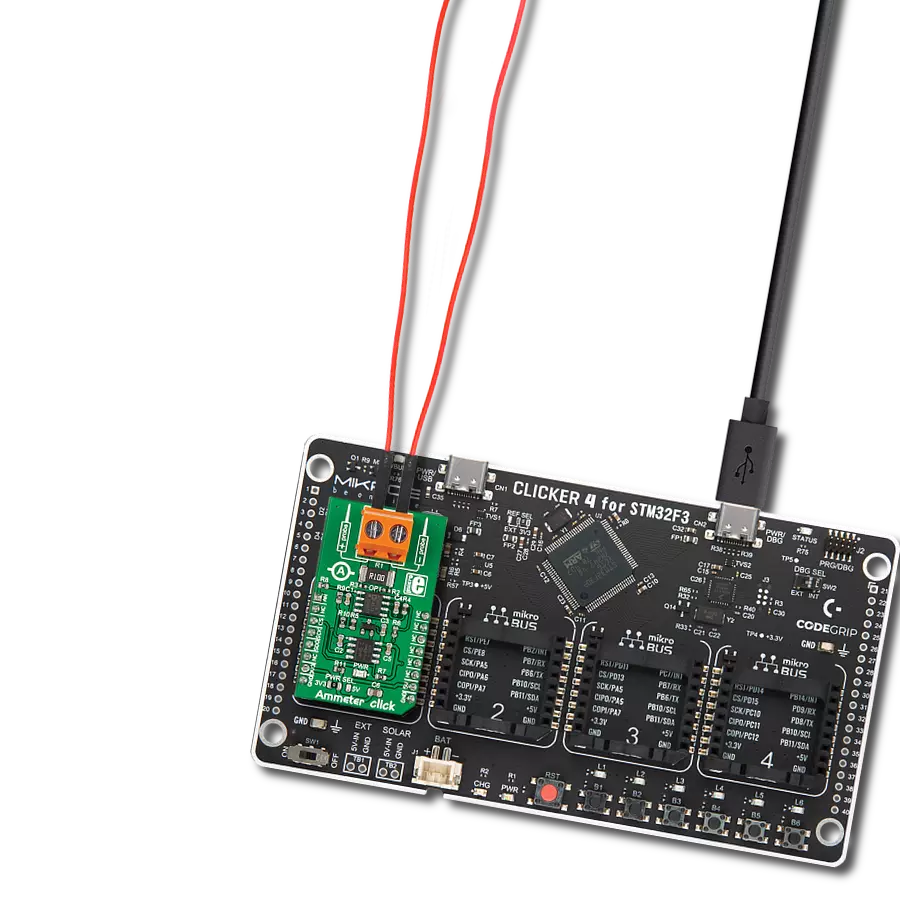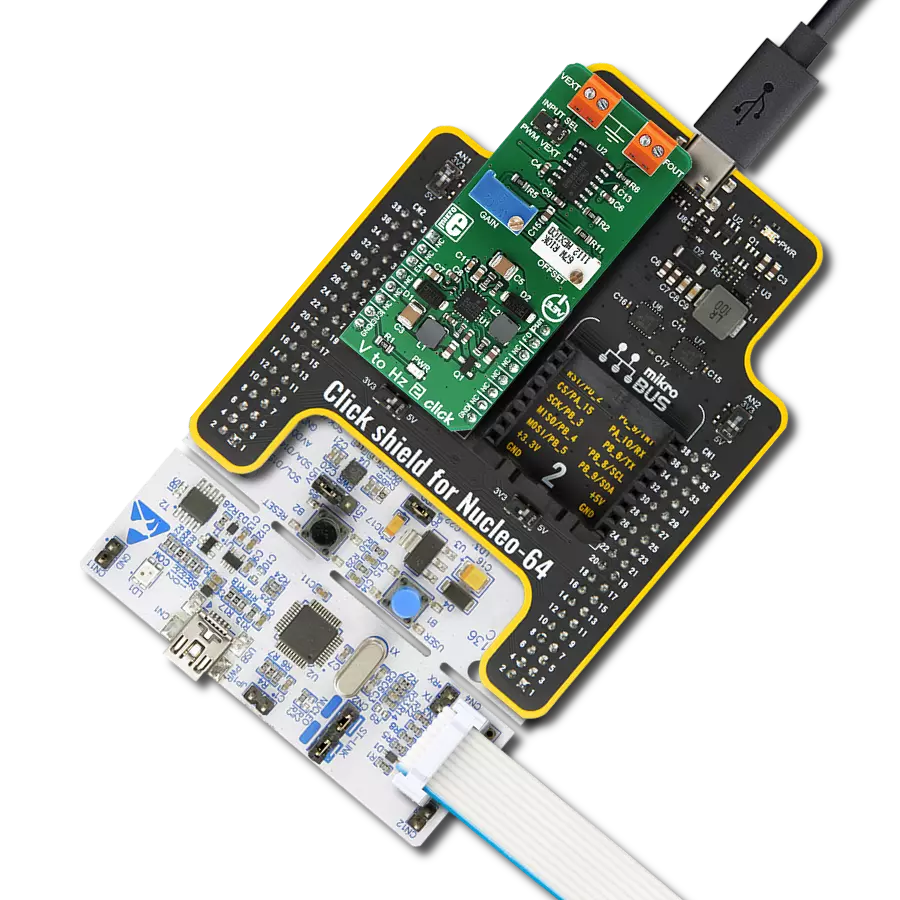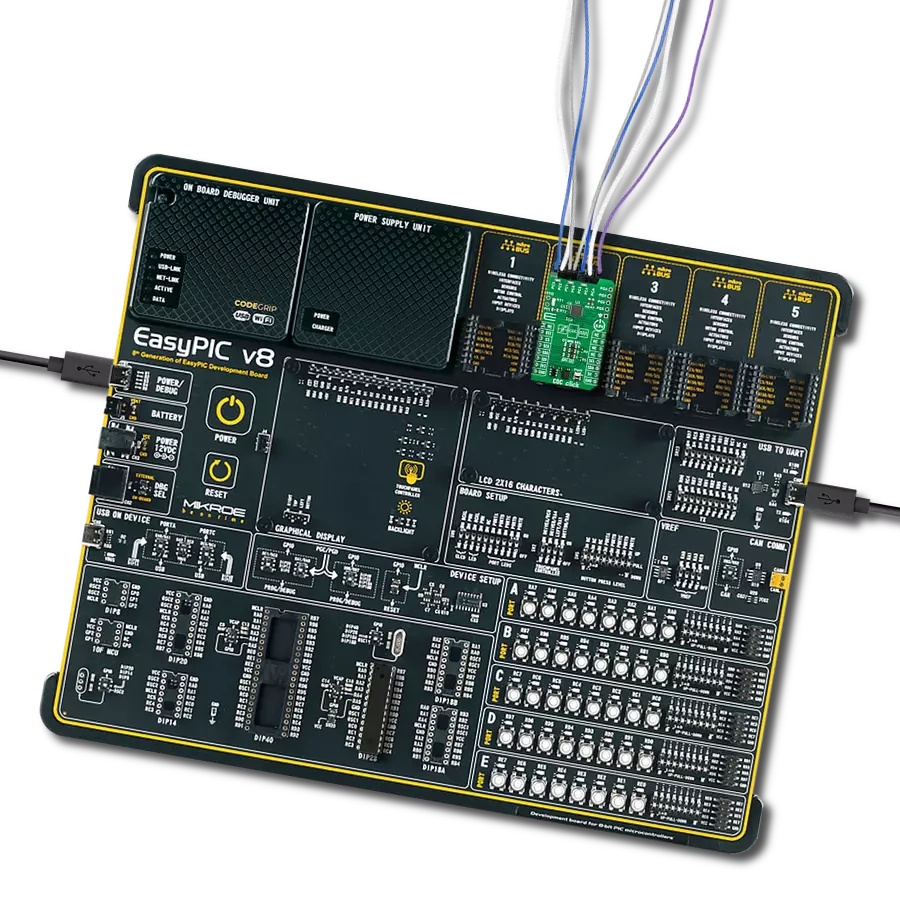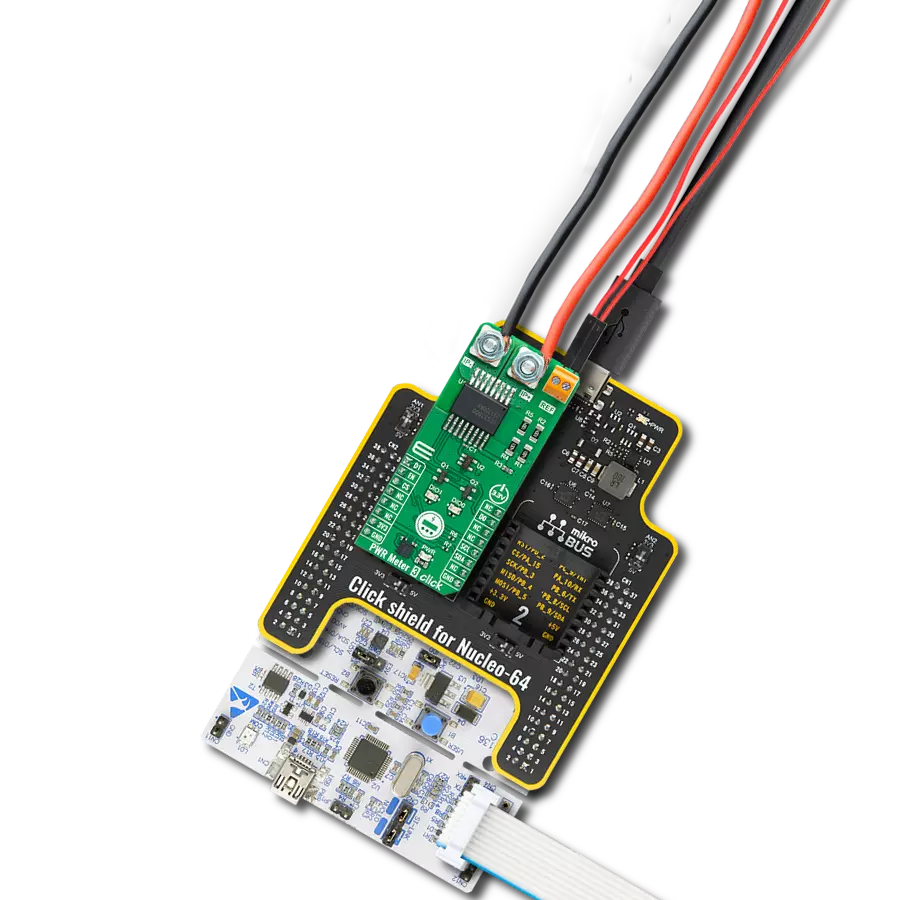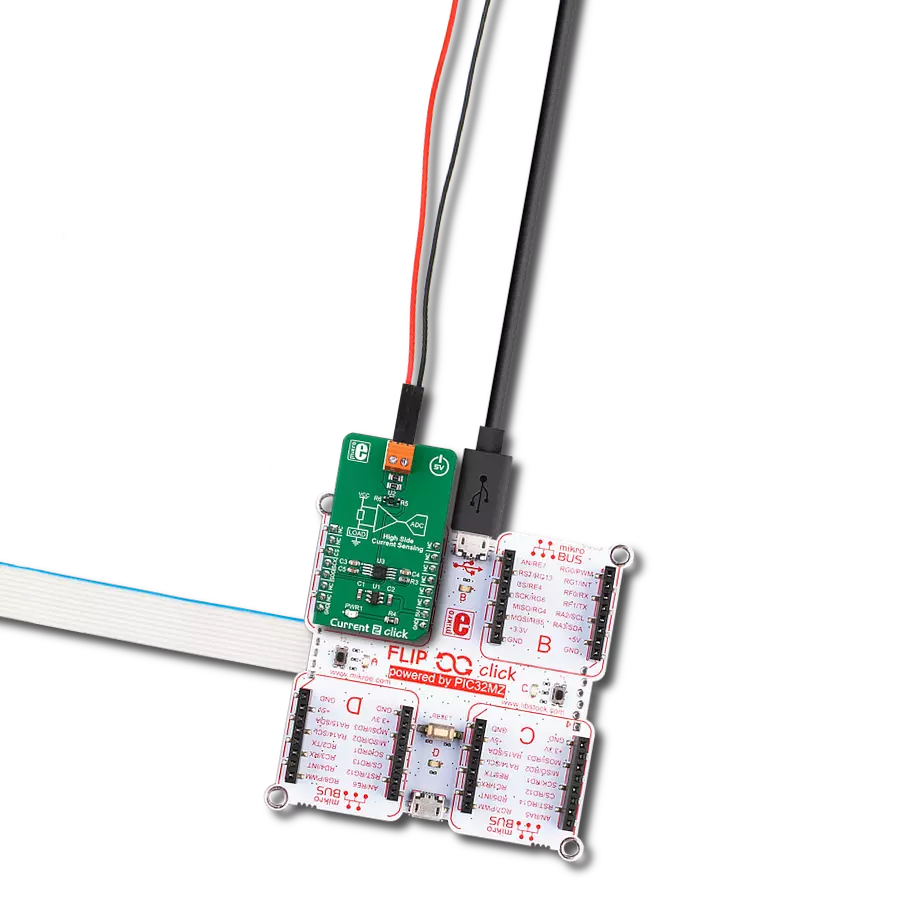Accurately measure the amount of oxygen dissolved in liquids like water, and enjoy tasks such as monitoring water quality in aquariums or conducting scientific experiments where precise oxygen measurement is crucial
A
A
Hardware Overview
How does it work?
EZO Carrier Click - Oxygen is based on the EZO-DO™, an ISO 5814 compliant embedded dissolved oxygen circuit board from Atlas Scientific. It allows you to interface any galvanic measurement probe, which determines the dissolved oxygen of a liquid in your application, by sinking the probe into the solvent you want to measure the oxygen. The EZO Carrier Click - Oxygen comes with the BNC connector for interfacing the appropriate probe, which MIKROE also offers. The EZO-DO™ needs to be isolated from the host MCU; therefore, this Click™ board comes with the Si8400AB, a bidirectional isolator from Skyworks. The isolator provides standard bidirectional and I2C communication with a clock frequency of up to 1.7MHz. The EZO-DO™ circuit is a very sensitive
device, and the sensitivity is what gives this circuit its accuracy. It can read micro-voltages that are bleeding into the water from unnatural sources such as pumps, solenoid valves, or other probes/sensors. So, to eliminate the electrical noise, besides the Si8400AB isolator, the power supply voltage is also isolated. For this purpose, this Click™ board is equipped with the ROE-0505S, a DC/DC converter from Recom. The EZO-DO™ has a flexible calibration protocol allowing for single-point, two-point, or three-point calibration. The temperature compensation should be taken into account. The EZO-DO™ features sleep mode, continuous operation, find function, export/import calibration, on-module status LED, and many more features. EZO Carrier Click - Oxygen can use a
standard 2-wire UART interface to communicate with the host MCU with the default baud rate of 9600bps. While using the UART interface, you can use the library we provide or a simple ASCII set of commands. You can also choose a standard 2-wire I2C interface over the COMM SEL jumpers. This Click board™ can operate with either 3.3V or 5V logic voltage levels selected via the VCC SEL jumper. This way, both 3.3V and 5V capable MCUs can use the communication lines properly. Also, this Click board™ comes equipped with a library containing easy-to-use functions and an example code that can be used as a reference for further development.
Features overview
Development board
Arduino UNO is a versatile microcontroller board built around the ATmega328P chip. It offers extensive connectivity options for various projects, featuring 14 digital input/output pins, six of which are PWM-capable, along with six analog inputs. Its core components include a 16MHz ceramic resonator, a USB connection, a power jack, an
ICSP header, and a reset button, providing everything necessary to power and program the board. The Uno is ready to go, whether connected to a computer via USB or powered by an AC-to-DC adapter or battery. As the first USB Arduino board, it serves as the benchmark for the Arduino platform, with "Uno" symbolizing its status as the
first in a series. This name choice, meaning "one" in Italian, commemorates the launch of Arduino Software (IDE) 1.0. Initially introduced alongside version 1.0 of the Arduino Software (IDE), the Uno has since become the foundational model for subsequent Arduino releases, embodying the platform's evolution.
Microcontroller Overview
MCU Card / MCU
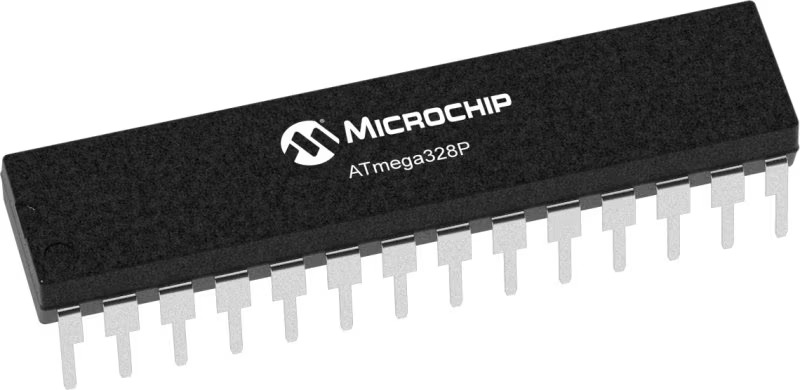
Architecture
AVR
MCU Memory (KB)
32
Silicon Vendor
Microchip
Pin count
28
RAM (Bytes)
2048
You complete me!
Accessories
Click Shield for Arduino UNO has two proprietary mikroBUS™ sockets, allowing all the Click board™ devices to be interfaced with the Arduino UNO board without effort. The Arduino Uno, a microcontroller board based on the ATmega328P, provides an affordable and flexible way for users to try out new concepts and build prototypes with the ATmega328P microcontroller from various combinations of performance, power consumption, and features. The Arduino Uno has 14 digital input/output pins (of which six can be used as PWM outputs), six analog inputs, a 16 MHz ceramic resonator (CSTCE16M0V53-R0), a USB connection, a power jack, an ICSP header, and reset button. Most of the ATmega328P microcontroller pins are brought to the IO pins on the left and right edge of the board, which are then connected to two existing mikroBUS™ sockets. This Click Shield also has several switches that perform functions such as selecting the logic levels of analog signals on mikroBUS™ sockets and selecting logic voltage levels of the mikroBUS™ sockets themselves. Besides, the user is offered the possibility of using any Click board™ with the help of existing bidirectional level-shifting voltage translators, regardless of whether the Click board™ operates at a 3.3V or 5V logic voltage level. Once you connect the Arduino UNO board with our Click Shield for Arduino UNO, you can access hundreds of Click boards™, working with 3.3V or 5V logic voltage levels.
The Atlas Scientific conductivity probe, known as Probe K, stands out for its stable and precise readings across a wide range of conductivity. Free from fringe effects, it ensures accuracy within a range of 5 to 200,000μS/cm, with an impressive accuracy of ±2%. Responding swiftly, it achieves 90% accuracy in just 1 second, making it ideal for real-time monitoring applications. With a broad temperature range from 1 to 110°C, it can withstand diverse environmental conditions. Its robust construction allows for a maximum pressure of 3,447kPa (500PSI) and a maximum depth of 352 meters (1,157 feet). A 1-meter cable provides installation flexibility. Probe K boasts a long recalibration interval of approximately ten years, aligning with its equally impressive life expectancy. Probe K ensures reliable conductivity measurements for a decade and beyond with these features.
Used MCU Pins
mikroBUS™ mapper
Take a closer look
Click board™ Schematic

Step by step
Project assembly
Software Support
Library Description
This library contains API for EZO Carrier Click - Oxygen Click driver.
Key functions:
ezocarrierdo_send_cmd- Send command functionezocarrierdo_send_cmd_with_par- Send command function with parameterezocarrierdo_send_cmd_check- Check the sent command
Open Source
Code example
The complete application code and a ready-to-use project are available through the NECTO Studio Package Manager for direct installation in the NECTO Studio. The application code can also be found on the MIKROE GitHub account.
/*!
* @file main.c
* @brief EZO Carrier DO Click Example.
*
* # Description
* This example demonstrates the use of EZO Carrier DO Click board by processing
* the incoming data and displaying them on the USB UART.
*
* The demo application is composed of two sections :
*
* ## Application Init
* Initializes the driver, performs the Click default factory reset, and high point calibration.
*
* ## Application Task
* Reads and processes all incoming dissolved oxygen data from the probe, and displays them on the USB UART in mg/L.
*
* ## Additional Function
* - static void ezocarrierdo_clear_app_buf ( void )
* - static void ezocarrierdo_log_app_buf ( void )
* - static err_t ezocarrierdo_process ( ezocarrierdo_t *ctx )
* - static err_t ezocarrierdo_rsp_check ( ezocarrierdo_t *ctx, uint8_t *rsp )
* - static void ezocarrierdo_error_check ( err_t error_flag )
*
* @author Stefan Ilic
*
*/
#include "board.h"
#include "log.h"
#include "ezocarrierdo.h"
// Application buffer size
#define APP_BUFFER_SIZE 200
#define PROCESS_BUFFER_SIZE 200
static ezocarrierdo_t ezocarrierdo;
static log_t logger;
static uint8_t app_buf[ APP_BUFFER_SIZE ] = { 0 };
static int32_t app_buf_len = 0;
static err_t error_flag;
/**
* @brief EZO Carrier DO clearing application buffer.
* @details This function clears memory of application buffer and reset its length.
* @note None.
*/
static void ezocarrierdo_clear_app_buf ( void );
/**
* @brief EZO Carrier DO log application buffer.
* @details This function logs data from application buffer to USB UART.
* @note None.
*/
static void ezocarrierdo_log_app_buf ( void );
/**
* @brief EZO Carrier DO data reading function.
* @details This function reads data from device and concatenates data to application buffer.
* @param[in] ctx : Click context object.
* See #ezocarrierdo_t object definition for detailed explanation.
* @return @li @c 0 - Read some data.
* @li @c -1 - Nothing is read.
* See #err_t definition for detailed explanation.
* @note None.
*/
static err_t ezocarrierdo_process ( ezocarrierdo_t *ctx );
/**
* @brief Response check.
* @details This function checks for response and
* returns the status of response.
* @param[in] rsp Expected response.
* @return @li @c 0 - OK response.
* @li @c -1 - Error response.
* @li @c -2 - Timeout error.
* See #err_t definition for detailed explanation.
*/
static err_t ezocarrierdo_rsp_check ( ezocarrierdo_t *ctx, uint8_t *rsp );
/**
* @brief Check for errors.
* @details This function checks for different types of
* errors and logs them on UART or logs the response if no errors occured.
* @param[in] error_flag Error flag to check.
*/
static void ezocarrierdo_error_check ( err_t error_flag );
void application_init ( void )
{
log_cfg_t log_cfg; /**< Logger config object. */
ezocarrierdo_cfg_t ezocarrierdo_cfg; /**< Click config object. */
/**
* Logger initialization.
* Default baud rate: 115200
* Default log level: LOG_LEVEL_DEBUG
* @note If USB_UART_RX and USB_UART_TX
* are defined as HAL_PIN_NC, you will
* need to define them manually for log to work.
* See @b LOG_MAP_USB_UART macro definition for detailed explanation.
*/
LOG_MAP_USB_UART( log_cfg );
log_init( &logger, &log_cfg );
log_info( &logger, " Application Init " );
// Click initialization.
ezocarrierdo_cfg_setup( &ezocarrierdo_cfg );
EZOCARRIERDO_MAP_MIKROBUS( ezocarrierdo_cfg, MIKROBUS_1 );
if ( UART_ERROR == ezocarrierdo_init( &ezocarrierdo, &ezocarrierdo_cfg ) )
{
log_error( &logger, " Communication init." );
for ( ; ; );
}
log_printf( &logger, "Device status \r\n" );
ezocarrierdo_send_cmd( &ezocarrierdo, EZOCARRIERDO_CMD_STATUS );
error_flag = ezocarrierdo_rsp_check( &ezocarrierdo, EZOCARRIERDO_RSP_OK );
ezocarrierdo_error_check( error_flag );
log_printf( &logger, "Factory reset \r\n" );
ezocarrierdo_send_cmd( &ezocarrierdo, EZOCARRIERDO_CMD_FACTORY );
error_flag = ezocarrierdo_rsp_check( &ezocarrierdo, EZOCARRIERDO_RSP_READY );
ezocarrierdo_error_check( error_flag );
log_printf( &logger, "Device info \r\n" );
ezocarrierdo_send_cmd( &ezocarrierdo, EZOCARRIERDO_CMD_DEV_INFO );
error_flag = ezocarrierdo_rsp_check( &ezocarrierdo, EZOCARRIERDO_RSP_OK );
ezocarrierdo_error_check( error_flag );
uint8_t n_cnt = 0;
uint8_t last_reading[ APP_BUFFER_SIZE ] = { 0 };
ezocarrierdo_clear_app_buf( );
ezocarrierdo_send_cmd( &ezocarrierdo, EZOCARRIERDO_CMD_SINGLE_READ );
ezocarrierdo_process ( &ezocarrierdo );
strcpy( last_reading, app_buf );
log_printf( &logger, "High point calibration \r\n" );
log_printf( &logger, "Waiting for stable readings \r\n" );
while ( n_cnt <= 5 )
{
if ( EZOCARRIERDO_OK == ezocarrierdo_process ( &ezocarrierdo ) )
{
if ( 0 == strstr( app_buf, last_reading ) )
{
n_cnt++;
}
else
{
strcpy( last_reading, app_buf );
n_cnt = 0;
}
}
log_printf( &logger, "- " );
Delay_ms ( 1000 );
ezocarrierdo_clear_app_buf( );
}
log_printf( &logger, "\r\n Calibration \r\n" );
ezocarrierdo_send_cmd( &ezocarrierdo, EZOCARRIERDO_CMD_CAL );
error_flag = ezocarrierdo_rsp_check( &ezocarrierdo, EZOCARRIERDO_RSP_OK );
ezocarrierdo_error_check( error_flag );
#define DISABLE_CONT_READ "0"
log_printf( &logger, "Disable continuous reading mode \r\n" );
ezocarrierdo_send_cmd_with_par( &ezocarrierdo, EZOCARRIERDO_CMD_CONT_READ, DISABLE_CONT_READ );
error_flag = ezocarrierdo_rsp_check( &ezocarrierdo, EZOCARRIERDO_RSP_OK );
ezocarrierdo_error_check( error_flag );
log_info( &logger, " Application Task " );
}
void application_task ( void )
{
log_printf( &logger, "Reading... \r\n" );
ezocarrierdo_send_cmd( &ezocarrierdo, EZOCARRIERDO_CMD_SINGLE_READ );
error_flag = ezocarrierdo_rsp_check( &ezocarrierdo, EZOCARRIERDO_RSP_OK );
ezocarrierdo_error_check( error_flag );
Delay_ms ( 1000 );
Delay_ms ( 1000 );
Delay_ms ( 1000 );
Delay_ms ( 1000 );
Delay_ms ( 1000 );
}
int main ( void )
{
/* Do not remove this line or clock might not be set correctly. */
#ifdef PREINIT_SUPPORTED
preinit();
#endif
application_init( );
for ( ; ; )
{
application_task( );
}
return 0;
}
static void ezocarrierdo_clear_app_buf ( void )
{
memset( app_buf, 0, app_buf_len );
app_buf_len = 0;
}
static void ezocarrierdo_log_app_buf ( void )
{
for ( int32_t buf_cnt = 0; buf_cnt < app_buf_len; buf_cnt++ )
{
log_printf( &logger, "%c", app_buf[ buf_cnt ] );
}
}
static err_t ezocarrierdo_process ( ezocarrierdo_t *ctx )
{
uint8_t rx_buf[ PROCESS_BUFFER_SIZE ] = { 0 };
int32_t overflow_bytes = 0;
int32_t rx_cnt = 0;
int32_t rx_size = ezocarrierdo_generic_read( ctx, rx_buf, PROCESS_BUFFER_SIZE );
if ( ( rx_size > 0 ) && ( rx_size <= APP_BUFFER_SIZE ) )
{
if ( ( app_buf_len + rx_size ) > APP_BUFFER_SIZE )
{
overflow_bytes = ( app_buf_len + rx_size ) - APP_BUFFER_SIZE;
app_buf_len = APP_BUFFER_SIZE - rx_size;
memmove ( app_buf, &app_buf[ overflow_bytes ], app_buf_len );
memset ( &app_buf[ app_buf_len ], 0, overflow_bytes );
}
for ( rx_cnt = 0; rx_cnt < rx_size; rx_cnt++ )
{
if ( rx_buf[ rx_cnt ] )
{
app_buf[ app_buf_len++ ] = rx_buf[ rx_cnt ];
}
}
return EZOCARRIERDO_OK;
}
return EZOCARRIERDO_ERROR;
}
static err_t ezocarrierdo_rsp_check ( ezocarrierdo_t *ctx, uint8_t *rsp )
{
uint32_t timeout_cnt = 0;
uint32_t timeout = 10000;
err_t error_flag = EZOCARRIERDO_OK;
ezocarrierdo_clear_app_buf( );
while ( ( 0 == strstr( app_buf, rsp ) ) &&
( 0 == strstr( app_buf, EZOCARRIERDO_RSP_ERROR ) ) )
{
error_flag |= ezocarrierdo_process( ctx );
if ( timeout_cnt++ > timeout )
{
ezocarrierdo_clear_app_buf( );
return EZOCARRIERDO_ERROR_TIMEOUT;
}
Delay_ms ( 1 );
}
Delay_ms ( 100 );
error_flag |= ezocarrierdo_process( ctx );
if ( strstr( app_buf, rsp ) )
{
return EZOCARRIERDO_OK;
}
else if ( strstr( app_buf, EZOCARRIERDO_RSP_ERROR ) )
{
return EZOCARRIERDO_ERROR;
}
else
{
return EZOCARRIERDO_ERROR;
}
}
static void ezocarrierdo_error_check ( err_t error_flag )
{
switch ( error_flag )
{
case EZOCARRIERDO_OK:
{
ezocarrierdo_log_app_buf( );
break;
}
case EZOCARRIERDO_ERROR:
{
log_error( &logger, " Error!" );
break;
}
case EZOCARRIERDO_ERROR_TIMEOUT:
{
log_error( &logger, " Timeout!" );
break;
}
default:
{
log_error( &logger, " Unknown!" );
break;
}
}
log_printf( &logger, "- - - - - - - - - - - - - - -\r\n" );
Delay_ms ( 500 );
}
// ------------------------------------------------------------------------ END
Additional Support
Resources
Category:Measurements





















